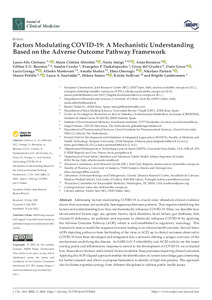Factors Modulating COVID-19 : A Mechanistic Understanding Based on the Adverse Outcome Pathway Framework
Clerbaux, Laure Alix; Albertini, Maria Cristina; Amigó, Núria; Beronius, Anna; Bezemer, Gillina F.G.; Coecke, Sandra; Daskalopoulos, Evangelos P.; del Giudice, Giusy; Greco, Dario; Grenga, Lucia; Mantovani, Alberto; Muñoz, Amalia; Omeragic, Elma; Parissis, Nikolaos; Petrillo, Mauro; Saarimäki, Laura A.; Soares, Helena; Sullivan, Kristie; Landesmann, Brigitte (2022-08)
Clerbaux, Laure Alix
Albertini, Maria Cristina
Amigó, Núria
Beronius, Anna
Bezemer, Gillina F.G.
Coecke, Sandra
Daskalopoulos, Evangelos P.
del Giudice, Giusy
Greco, Dario
Grenga, Lucia
Mantovani, Alberto
Muñoz, Amalia
Omeragic, Elma
Parissis, Nikolaos
Petrillo, Mauro
Saarimäki, Laura A.
Soares, Helena
Sullivan, Kristie
Landesmann, Brigitte
08 / 2022
4464
Julkaisun pysyvä osoite on
https://urn.fi/URN:NBN:fi:tuni-202209157090
https://urn.fi/URN:NBN:fi:tuni-202209157090
Kuvaus
Peer reviewed
Tiivistelmä
Addressing factors modulating COVID-19 is crucial since abundant clinical evidence shows that outcomes are markedly heterogeneous between patients. This requires identifying the factors and understanding how they mechanistically influence COVID-19. Here, we describe how eleven selected factors (age, sex, genetic factors, lipid disorders, heart failure, gut dysbiosis, diet, vitamin D deficiency, air pollution and exposure to chemicals) influence COVID-19 by applying the Adverse Outcome Pathway (AOP), which is well-established in regulatory toxicology. This framework aims to model the sequence of events leading to an adverse health outcome. Several linear AOPs depicting pathways from the binding of the virus to ACE2 up to clinical outcomes observed in COVID-19 have been developed and integrated into a network offering a unique overview of the mechanisms underlying the disease. As SARS-CoV-2 infectibility and ACE2 activity are the major starting points and inflammatory response is central in the development of COVID-19, we evaluated how those eleven intrinsic and extrinsic factors modulate those processes impacting clinical outcomes. Applying this AOP-aligned approach enables the identification of current knowledge gaps orientating for further research and allows to propose biomarkers to identify of high-risk patients. This approach also facilitates expertise synergy from different disciplines to address public health issues.
Kokoelmat
- TUNICRIS-julkaisut [16929]
